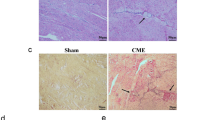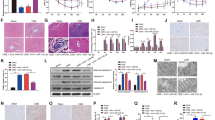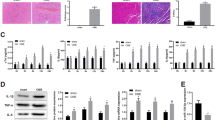Abstract
Coronary microembolization (CME) is an intractable complication results from acute coronary syndrome. CME-induced myocardial apoptosis was associated with progressive cardiac contractile dysfunction. miR-29b-3p has been reported implicated in variety cardiovascular diseases, but its function in CME-induced myocardial injury is yet unknown. Herein, a rat model of CME was established by injecting microspheres into the left ventricle and found that the expression level of miR-29b-3p was markedly decreased in the CME rat heart tissues. By using echocardiography, CD31 immunohistochemistry staining, hematoxylin basic fuchsin picric acid (HBFP) staining, TUNEL staining, and western blotting analysis after CME, it was found that upregulating miR-29b-3p improved cardiac dysfunction, promoted angiogenesis, decreased myocardial microinfarct area, and inhibited myocardial apoptosis. Additionally, miR-29b-3p inhibition can reverse the protective benefits of miR-29b-3p overexpression. Mechanistically, the target genes of miR-29b-3p were identified as glycogen synthase kinase 3 (GSK-3β) and Bcl-2 modifying factor (BMF) by bioinformatics analysis and luciferase reporter experiment. Overall, our findings imply that induction of miR-29b-3p, which negatively regulates GSK-3β and BMF expression, attenuates CME-induced myocardial injury, suggesting a novel potential therapeutic target for cardioprotective after CME.





Similar content being viewed by others
Data availability
The datasets used or analyzed during the current study are available from the corresponding author on reasonable request.
References
Kleinbongard P, Heusch G (2022) A fresh look at coronary microembolization. Nat Rev Cardiol 19(4):265–280
Skyschally A, Walter B, Heusch G (2013) Coronary microembolization during early reperfusion: infarct extension, but protection by ischaemic postconditioning. Eur Heart J 34(42):3314–3321
Taqueti VR, Solomon SD, Shah AM et al (2018) Coronary microvascular dysfunction and future risk of heart failure with preserved ejection fraction. Eur Heart J 39(10):840–849
Heusch G (2020) Myocardial ischaemia-reperfusion injury and cardioprotection in perspective. Nat Rev Cardiol 17(12):773–789
de Waha S, Patel MR, Granger CB et al (2017) Relationship between microvascular obstruction and adverse events following primary percutaneous coronary intervention for ST-segment elevation myocardial infarction: an individual patient data pooled analysis from seven randomized trials. Eur Heart J 38(47):3502–3510
Su Q, Lv X, Sun Y et al (2018) Role of TLR4/MyD88/NF-κB signaling pathway in coronary microembolization-induced myocardial injury prevented and treated with nicorandil. Biomed Pharmacother 106:776–784
Qin Z, Kong B, Zheng J et al (2020) Alprostadil injection attenuates coronary microembolization-induced myocardial injury through GSK-3β/Nrf2/HO-1 signaling-mediated apoptosis inhibition. Drug Des Devel Ther 14:4407–4422
Jonas S, Izaurralde E (2015) Towards a molecular understanding of microRNA-mediated gene silencing. Nat Rev Genet 16(7):421–433
Ha M, Kim VN (2014) Regulation of microRNA biogenesis. Nat Rev Mol Cell Biol 15(8):509–524
Zhou SS, Jin JP, Wang JQ et al (2018) miRNAS in cardiovascular diseases: potential biomarkers, therapeutic targets and challenges. Acta Pharmacol Sin 39(7):1073–1084
Liu MN, Luo G, Gao WJ et al (2021) miR-29 family: a potential therapeutic target for cardiovascular disease. Pharmacol Res 166:105510
van Rooij E, Sutherland LB, Thatcher JE et al (2008) Dysregulation of microRNAs after myocardial infarction reveals a role of miR-29 in cardiac fibrosis. Proc Natl Acad Sci U S A 105(35):13027–13032
Marques FZ, Vizi D, Khammy O et al (2016) The transcardiac gradient of cardio-microRNAs in the failing heart. Eur J Heart Fail 18(8):1000–1008
Cai Y, Li Y (2019) Upregulation of miR-29b-3p protects cardiomyocytes from hypoxia-induced apoptosis by targeting TRAF5. Cell Mol Biol Lett 24:27
Li L, Zhao X, Lu Y et al (2010) Altered expression of pro- and anti-inflammatory cytokines is associated with reduced cardiac function in rats following coronary microembolization. Mol Cell Biochem 342(1–2):183–190
Weidner N, Folkman J, Pozza F et al (1992) Tumor angiogenesis: a new significant and independent prognostic indicator in early-stage breast carcinoma. J Natl Cancer Inst 84(24):1875–1887
Widlansky ME, Jensen DM, Wang J et al (2018) miR-29 contributes to normal endothelial function and can restore it in cardiometabolic disorders. EMBO Mol Med 10(3):e8046
Yang J, Gao J, Gao F et al (2022) Extracellular vesicles-encapsulated microRNA-29b-3p from bone marrow-derived mesenchymal stem cells promotes fracture healing via modulation of the PTEN/PI3K/AKT axis. Exp Cell Res 412(2):113026
Xiao X, Li W, Rong D et al (2021) Human umbilical cord mesenchymal stem cells-derived extracellular vesicles facilitate the repair of spinal cord injury via the miR-29b-3p/PTEN/Akt/mTOR axis. Cell Death Discov 7(1):212
Heusch G, Kleinbongard P, Böse D et al (2009) Coronary microembolization: from bedside to bench and back to bedside. Circulation 120(18):1822–1836
Lu D, Thum T (2019) RNA-based diagnostic and therapeutic strategies for cardiovascular disease. Nat Rev Cardiol 16(11):661–674
Small EM, Frost RJ, Olson EN (2010) MicroRNAs add a new dimension to cardiovascular disease. Circulation 121(8):1022–1032
Zhu L, Li N, Sun L et al (2021) Non-coding RNAs: the key detectors and regulators in cardiovascular disease. Genomics 113(1 Pt 2):1233–1246
Puthalakath H, Villunger A, O’Reilly LA et al (2001) Bmf: a proapoptotic BH3-only protein regulated by interaction with the myosin V actin motor complex, activated by anoikis. Science 293(5536):1829–1832
Singh R, Letai A, Sarosiek K (2019) Regulation of apoptosis in health and disease: the balancing act of BCL-2 family proteins. Nat Rev Mol Cell Biol 20(3):175–193
Banjara S, Suraweera CD, Hinds MG et al (2020) The Bcl-2 family: ancient origins, conserved structures, and divergent mechanisms. Biomolecules 10(1):128
Kaga S, Zhan L, Altaf E et al (2006) Glycogen synthase kinase-3beta/beta-catenin promotes angiogenic and anti-apoptotic signaling through the induction of VEGF, Bcl-2 and survivin expression in rat ischemic preconditioned myocardium. J Mol Cell Cardiol 40(1):138–147
Potz BA, Sabe AA, Elmadhun NY et al (2016) Glycogen synthase kinase 3β inhibition improves myocardial angiogenesis and perfusion in a swine model of metabolic syndrome. J Am Heart Assoc 5(7):e003694
Hoang MV, Nagy JA, Senger DR (2011) Cdc42-mediated inhibition of GSK-3β improves angio-architecture and lumen formation during VEGF-driven pathological angiogenesis. Microvasc Res 81(1):34–43
Huang S, Li X, Zheng H et al (2019) Loss of super-enhancer-regulated circRNA Nfix induces cardiac regeneration after myocardial infarction in adult mice. Circulation 139(25):2857–2876
Kriegel AJ, Liu Y, Fang Y et al (2012) The miR-29 family: genomics, cell biology, and relevance to renal and cardiovascular injury. Physiol Genomics 44:237–244
Li Z, Yi N, Chen R et al (2020) miR-29b-3p protects cardiomyocytes against endotoxin-induced apoptosis and inflammatory response through targeting FOXO3A. Cell Signal 74:109716
Suárez Y, Fernández-Hernando C et al (2007) Dicer dependent microRNAs regulate gene expression and functions in human endothelial cells. Circ Res 100(8):1164–1173
Poliseno L, Tuccoli A, Mariani L et al (2006) MicroRNAs modulate the angiogenic properties of HUVECs. Blood 108(9):3068–3071
Urbich C, Kuehbacher A, Dimmeler S (2008) Role of microRNAs in vascular diseases, inflammation, and angiogenesis. Cardiovasc Res 79(4):581–588
Sassi Y, Avramopoulos P, Ramanujam D et al (2017) Cardiac myocyte miR-29 promotes pathological remodeling of the heart by activating Wnt signaling. Nat Commun 8(1):1614
Funding
This work was supported from the Project for Innovative Research Team in Guangxi Natural Science Foundation (No. 2018GXNSFGA281006), National Nature Science Foundation of China (No. 82170349, No. 81900318), and Guangxi Natural Science Foundation (No. 2018GXNSFBA050017).
Author information
Authors and Affiliations
Contributions
LL and XW conceived the project and designed experiments. ZQ, XW, YZ, JZ and HL performed the experiments. ZQ and XW analyzed the data. ZQ and LL wrote the manuscript.
Corresponding author
Ethics declarations
Conflict of interest
The authors declare there are no conflicts of interest.
Additional information
Publisher's Note
Springer Nature remains neutral with regard to jurisdictional claims in published maps and institutional affiliations.
Rights and permissions
Springer Nature or its licensor (e.g. a society or other partner) holds exclusive rights to this article under a publishing agreement with the author(s) or other rightsholder(s); author self-archiving of the accepted manuscript version of this article is solely governed by the terms of such publishing agreement and applicable law.
About this article
Cite this article
Qin, Z., Wang, X., Zhou, Y. et al. Upregulation of miR-29b-3p alleviates coronary microembolization-induced myocardial injury via regulating BMF and GSK-3β. Apoptosis 28, 210–221 (2023). https://doi.org/10.1007/s10495-022-01788-z
Accepted:
Published:
Issue Date:
DOI: https://doi.org/10.1007/s10495-022-01788-z




